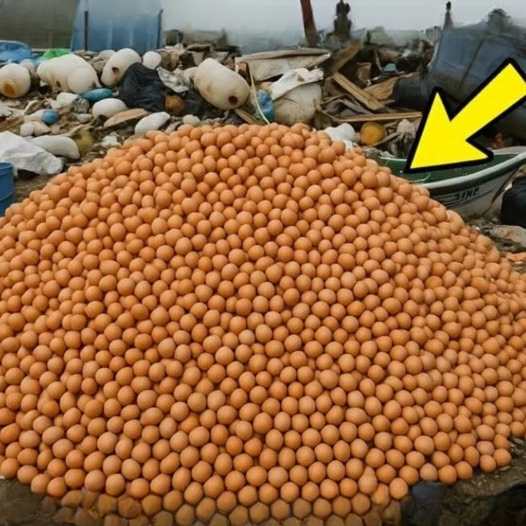THE CHICKS FROM NOWHERE: A MIRACLE IN THE LANDFILL
In the early days of spring, when pale sunlight filtered through budding trees, the city hummed with its usual rhythms. Vendors set up their stalls, shoppers browsed supermarkets, and children walked home with backpacks bouncing on their shoulders. Nothing seemed out of the ordinary—yet, beneath this calm surface, something quietly unusual was unfolding.
It began innocuously enough. During a routine health-inspection sweep, municipal officials discovered a local distributor holding roughly twenty thousand chicken eggs unfit for sale. Many were past expiration, cracked, dirty, or improperly stored. Authorities collected and labeled the eggs as unsafe, loading them onto trucks bound for the city landfill—a grim expanse of rusting metal, decomposing refuse, and the hum of mechanical compactors.
At the landfill, the eggs were dumped alongside broken furniture, discarded appliances, spoiled food, and yard clippings. Over the following weeks, rain collapsed the cardboard cartons, some eggs cracked under pressure, others sank into mud, and scavenging birds pecked at the rest. Life seemed to move on, the eggs forgotten, the event a minor footnote in the city’s daily routine.
But then, nearly three months later, something extraordinary occurred.
It was just after first light on a quiet morning. Boris, an older landfill caretaker, arrived for his shift. He had long grown accustomed to the rhythms of the dump: gulls circling, rats scurrying, trucks rumbling. Today was different. The usual flock of crows hovered hesitantly, refusing to land. A hush fell over the waste heap.
Curious, Boris approached the mound, his boots sinking into slushy refuse. And then—he froze.
Among the rotting vegetables, torn plastic, and tangled wires, something was alive. Tiny, yellow, fluffy creatures were scuttling through the trash. Chicks. Dozens, perhaps hundreds, emerging amid the decay. Some were still damp from hatching, shell fragments clinging to their heads; others moved confidently, peeping softly as they explored the makeshift terrain.
How could this be? The conditions were harsh. Nights were cold. Rain had soaked the heap days before. No nest, no hen, no incubator. Yet life had emerged, seemingly unaided, as if the landfill itself had become an unlikely incubator.
By midmorning, word had spread. Curious residents, news crews, and scientists gathered at the fence, peering into the muck to witness the miracle. Children pointed, adults photographed, and scientists measured soil and temperature—but no explanation sufficed. The eggs should have spoiled; the chicks should have perished. Yet here they were.
Dubbed “chicks from nowhere,” the tiny birds became symbols of hope. Families adopted them, children carried them home in shoeboxes, and an elderly woman kept one, believing it carried the city’s promise: if life can emerge in a wasteland, renewal is possible anywhere. Schoolchildren visited with their teacher, taking chicks home safely and vowing to give them better lives.
The local government investigated but publicly admitted: “We cannot explain exactly how this happened.” Scientists theorized heat from composting waste or buried eggs incubating slowly—but the mystery remained. The citizens didn’t need an explanation. They had witnessed wonder.
As weeks passed, the chicks grew, their down replaced by feathers, their soft peeps by gentle clucks. Animal shelters re-homed many, while others became part of the city’s story. People passing the landfill no longer saw just trash—they remembered the chicks, a living reminder that life can emerge from the discarded, the forgotten, the broken.
The tale became legend: the “Landfill Hatching,” a story of resilience, renewal, and hope in the most unexpected places. And though the science might remain unclear, the emotional truth was unmistakable: life is unpredictable. It can appear where we least expect it. It can rise from debris. And sometimes, amid decay and neglect, nature whispers its quiet miracle.
